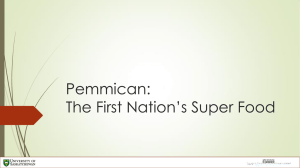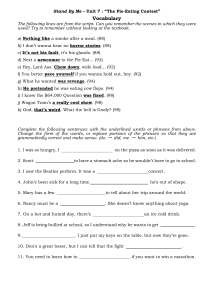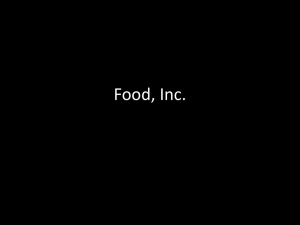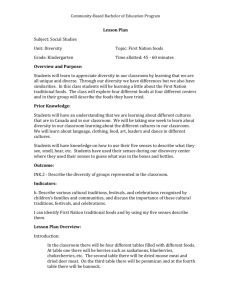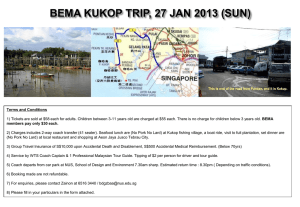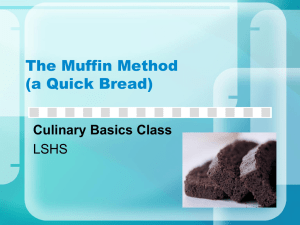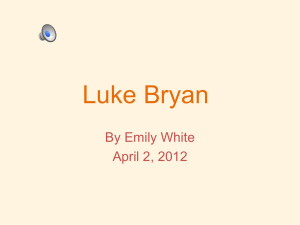Pemmican_Nutrition_Lesson_Plan
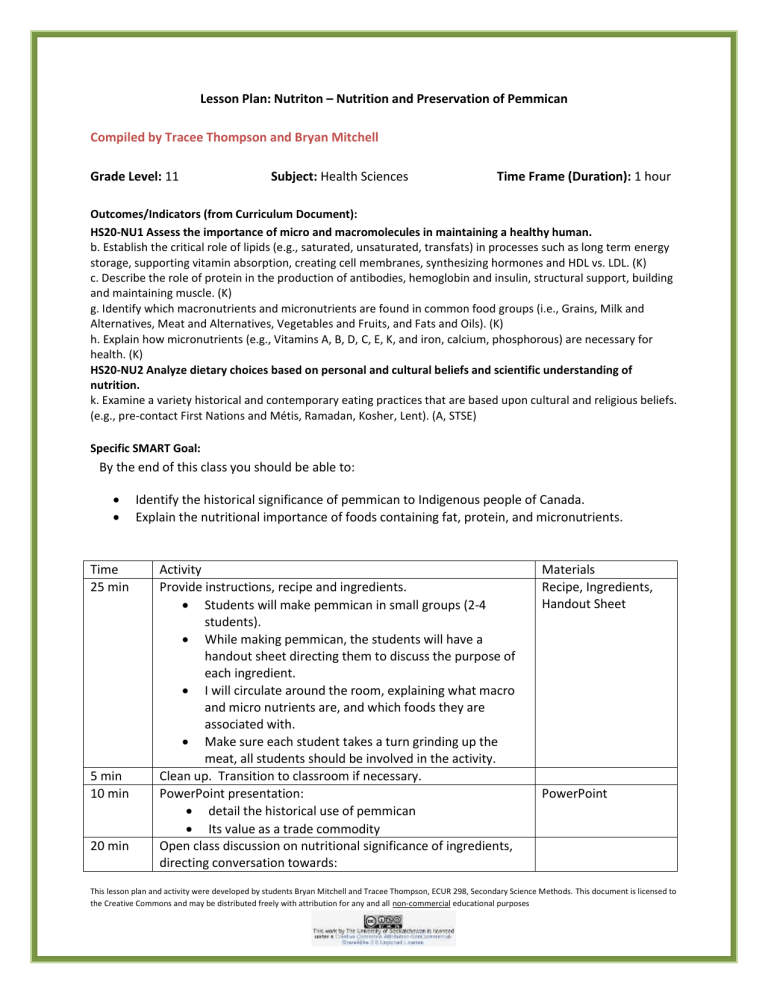
Lesson Plan: Nutriton – Nutrition and Preservation of Pemmican
Compiled by Tracee Thompson and Bryan Mitchell
Grade Level: 11 Subject: Health Sciences Time Frame (Duration): 1 hour
Outcomes/Indicators (from Curriculum Document):
HS20-NU1 Assess the importance of micro and macromolecules in maintaining a healthy human. b. Establish the critical role of lipids (e.g., saturated, unsaturated, transfats) in processes such as long term energy storage, supporting vitamin absorption, creating cell membranes, synthesizing hormones and HDL vs. LDL. (K) c. Describe the role of protein in the production of antibodies, hemoglobin and insulin, structural support, building and maintaining muscle. (K) g. Identify which macronutrients and micronutrients are found in common food groups (i.e., Grains, Milk and
Alternatives, Meat and Alternatives, Vegetables and Fruits, and Fats and Oils). (K) h. Explain how micronutrients (e.g., Vitamins A, B, D, C, E, K, and iron, calcium, phosphorous) are necessary for health. (K)
HS20-NU2 Analyze dietary choices based on personal and cultural beliefs and scientific understanding of nutrition. k. Examine a variety historical and contemporary eating practices that are based upon cultural and religious beliefs.
(e.g., pre-contact First Nations and Métis, Ramadan, Kosher, Lent). (A, STSE)
Specific SMART Goal:
By the end of this class you should be able to:
Identify the historical significance of pemmican to Indigenous people of Canada.
Explain the nutritional importance of foods containing fat, protein, and micronutrients.
Time
25 min
5 min
10 min
20 min
Activity
Provide instructions, recipe and ingredients.
Students will make pemmican in small groups (2-4 students).
While making pemmican, the students will have a handout sheet directing them to discuss the purpose of each ingredient.
I will circulate around the room, explaining what macro and micro nutrients are, and which foods they are associated with.
Make sure each student takes a turn grinding up the meat, all students should be involved in the activity.
Clean up. Transition to classroom if necessary.
PowerPoint presentation:
detail the historical use of pemmican
Its value as a trade commodity
Open class discussion on nutritional significance of ingredients, directing conversation towards:
Materials
Recipe, Ingredients,
Handout Sheet
PowerPoint
This lesson plan and activity were developed by students Bryan Mitchell and Tracee Thompson, ECUR 298, Secondary Science Methods. This document is licensed to the Creative Commons and may be distributed freely with attribution for any and all non-commercial educational purposes
Macronutrients
Micronutrients
Calories
If time permits, discuss role of fat in preservation of food.
Teaching skills to focus on:
Allow students to have open discussion during the activity portion of the class. Don’t direct or influence discussion at this point.
Maintain control of open class discussion and guide students toward the intended outcome.
Recipe:
Ingredients (per 2-3 students)
1 cup of dried meat jerky
½ cup of lard (crisco)
½ cup
Equipment needed
1 mortar and pestle
1 quart mixing bowl
Stove or heating plate
Sauce pot or metal beaker
Oven mitts
Stirring rod or spoon
Metal tablespoon
Muffin tin and muffin cups
Sink and dishsoap to clean up
Paper towel to absorb any spilled lard
Step-by-step
Wash your hands and all cooking materials
Using your mortar and pestle, grind up 1 or 2 strips of beef at a time into a powder
You’ll find this is harder, and takes longer than you think! Cutting the dried meat into smaller pieces will speed the process.
Set powdered meat aside in mixing bowl
Use your mortar and pestle again to grind your dried berries – much easier!
Pour dried berries in with your powdered meat and stir them until fully mixed
Add lard to your sauce pot or metal beaker and heat until melted, wear oven mitts, and stir constantly
This lesson plan and activity were developed by students Bryan Mitchell and Tracee Thompson, ECUR 298, Secondary Science Methods. This document is licensed to the Creative Commons and may be distributed freely with attribution for any and all non-commercial educational purposes
CAUTION: do not boil the lard, or overheat the lard, as it can catch fire if overheated. If this happens, cover the saucepot to starve the flame of oxygen, and carefully remove from the source of heat.
Once it is melted, carefully pour half of the lard into your mixing bowl, and mix thoroughly
Add the remaining lard by the table spoonful, until the mixture begins to stick together – you’ll know it is ready when it can form a small ball that doesn’t crumble apart.
Before it hardens, divide your m,ixture into small portions in the muffin cups, or by scoring in a baking tray, and enjoy!
To store, wrap the pemmican in a double layer of wax paper and tinfoil
Pemmican can last for months or even years if it is packaged correctly
As you are making the pemmican discuss in your group why you think each of the ingredients is used.
We will be discussing this in further detail as a class after everyone is finished making their pemmican.
This lesson plan and activity were developed by students Bryan Mitchell and Tracee Thompson, ECUR 298, Secondary Science Methods. This document is licensed to the Creative Commons and may be distributed freely with attribution for any and all non-commercial educational purposes
